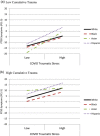The relationship of COVID-19 traumatic stress, cumulative trauma, and race to posttraumatic stress disorder symptoms
- PMID: 34855214
- PMCID: PMC9015429
- DOI: 10.1002/jcop.22762
The relationship of COVID-19 traumatic stress, cumulative trauma, and race to posttraumatic stress disorder symptoms
Abstract
The purpose of this study was to test if coronavirus disease 2019 (COVID-19) traumatic stress predicts posttraumatic stress disorder (PTSD) symptoms after cumulative trauma and whether there is a three-way interaction between COVID-19 traumatic stress, cumulative trauma, and race in the prediction of PTSD. Using a cross-sectional design, a diverse sample of 745 participants completed measures of cumulative trauma, COVID-19 traumatic stress, and PTSD. COVID-19 traumatic stress accounted for a significant amount of the variance in PTSD above and beyond cumulative trauma. A significant interaction effect was found, indicating that the effect of COVID-19 traumatic stress in predicting PTSD varied as a function of cumulative trauma and that the effects of that interaction were different for Asians and Whites. There were generally comparable associations between COVID-19 traumatic stress and PTSD at low and high levels of cumulative trauma across most racial groups. However, for Asians, higher levels of cumulative trauma did not worsen the PTSD outcome as a function of COVID Traumatic Stress but did at low levels of cumulative trauma.
Keywords: COVID-19 traumatic stress; cumulative trauma; race.
© 2021 Wiley Periodicals LLC.
Figures
References
-
- Brown, T. A. (2015). Confirmatory factor analysis for applied research (2nd ed.). The Guilford Press.
-
- Center for Disease Control and Prevention (2020, August 18). COVID‐19 hospitalization and death by race/ethnicity. Retrieved from https://www.cdc.gov/coronavirus/2019-ncov/covid-data/investigations-disc...
MeSH terms
LinkOut - more resources
Full Text Sources
Medical


